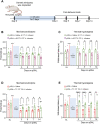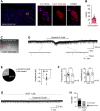Three-Day Continuous Oxytocin Infusion Attenuates Thermal and Mechanical Nociception by Rescuing Neuronal Chloride Homeostasis via Upregulation KCC2 Expression and Function
- PMID: 35401174
- PMCID: PMC8988046
- DOI: 10.3389/fphar.2022.845018
Three-Day Continuous Oxytocin Infusion Attenuates Thermal and Mechanical Nociception by Rescuing Neuronal Chloride Homeostasis via Upregulation KCC2 Expression and Function
Abstract
Oxytocin (OT) and its receptor are promising targets for the treatment and prevention of the neuropathic pain. In the present study, we compared the effects of a single and continuous intrathecal infusion of OT on nerve injury-induced neuropathic pain behaviours in mice and further explore the mechanisms underlying their analgesic properties. We found that three days of continuous intrathecal OT infusion alleviated subsequent pain behaviours for 14 days, whereas a single OT injection induced a transient analgesia for 30 min, suggesting that only continuous intrathecal OT attenuated the establishment and development of neuropathic pain behaviours. Supporting this behavioural finding, continuous intrathecal infusion, but not short-term incubation of OT, reversed the nerve injury-induced depolarizing shift in Cl- reversal potential via restoring the function and expression of spinal K+-Cl- cotransporter 2 (KCC2), which may be caused by OT-induced enhancement of GABA inhibitory transmission. This result suggests that only continuous use of OT may reverse the pathological changes caused by nerve injury, thereby mechanistically blocking the establishment and development of pain. These findings provide novel evidence relevant for advancing understanding of the effects of continuous OT administration on the pathophysiology of pain.
Keywords: K+-Cl-cotransporter 2; chloride homeostasis; continuous intrathecal drug delivery; neuropathic pain; oxytocin.
Copyright © 2022 Ba, Ran, Guo, Guo, Zeng, Liu, Sun, Xiao, Xiong, Huang, Jiang and Hao.
Conflict of interest statement
The authors declare that the research was conducted in the absence of any commercial or financial relationships that could be construed as a potential conflict of interest.
Figures







Similar articles
-
Oxytocin Relieves Neuropathic Pain Through GABA Release and Presynaptic TRPV1 Inhibition in Spinal Cord.Front Mol Neurosci. 2018 Jul 17;11:248. doi: 10.3389/fnmol.2018.00248. eCollection 2018. Front Mol Neurosci. 2018. PMID: 30065629 Free PMC article.
-
Phα1β, a peptide from the venom of the spider Phoneutria nigriventer shows antinociceptive effects after continuous infusion in a neuropathic pain model in rats.Anesth Analg. 2014 Jul;119(1):196-202. doi: 10.1213/ANE.0000000000000249. Anesth Analg. 2014. PMID: 24836473
-
N-methyl-D-aspartate receptor- and calpain-mediated proteolytic cleavage of K+-Cl- cotransporter-2 impairs spinal chloride homeostasis in neuropathic pain.J Biol Chem. 2012 Sep 28;287(40):33853-64. doi: 10.1074/jbc.M112.395830. Epub 2012 Aug 1. J Biol Chem. 2012. PMID: 22854961 Free PMC article.
-
Therapeutic restoration of spinal inhibition via druggable enhancement of potassium-chloride cotransporter KCC2-mediated chloride extrusion in peripheral neuropathic pain.JAMA Neurol. 2014 May;71(5):640-5. doi: 10.1001/jamaneurol.2014.21. JAMA Neurol. 2014. PMID: 24615367 Free PMC article. Review.
-
The Role of K+-Cl--Cotransporter-2 in Neuropathic Pain.Neurochem Res. 2018 Jan;43(1):110-115. doi: 10.1007/s11064-017-2344-3. Epub 2017 Jul 4. Neurochem Res. 2018. PMID: 28677029 Review.
Cited by
-
Unraveling the socio-cognitive consequences of KCC2 disruption in zebrafish: implications for neurodevelopmental disorders and therapeutic interventions.Front Mol Neurosci. 2024 Oct 14;17:1483238. doi: 10.3389/fnmol.2024.1483238. eCollection 2024. Front Mol Neurosci. 2024. PMID: 39469188 Free PMC article.
-
Oxytocin Disturbs Vestibular Compensation and Modifies Behavioral Strategies in a Rodent Model of Acute Vestibulopathy.Int J Mol Sci. 2022 Dec 3;23(23):15262. doi: 10.3390/ijms232315262. Int J Mol Sci. 2022. PMID: 36499588 Free PMC article.
References
LinkOut - more resources
Full Text Sources
Other Literature Sources

